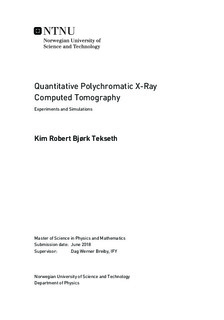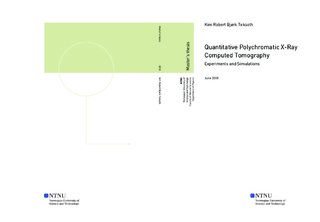| dc.description.abstract | X-ray Computed Tomography (CT) is an extensively used technique conventionally utilizing either absorption-contrast or phase-contrast to non-destructively image the internal structures of objects. While CT instruments using polychromatic source spectra might provide qualitative information about a sample, quantitative results are limited due to tomographic artifacts such as beam hardening. Beam hardening may be alleviated through energy filtration or using dual energy CT, however, quantitative CT is usually restricted to measurements using a monochromatic source.
This thesis has focused on two dimensional monochromatic and polychromatic CT simulations based on absorption-contrast. The polychromatic simulations aim to replicate a Nikon XT H 225 ST CT instrument by implementing models for the X-ray source and the X-ray detector, the focal spot size and the noise.
Simulated tomograms of three homogeneous and cylindrical samples consisting of polyoxymethylene, polytetrafluoroethylene and Al were compared to experimental data to verify the models used in the simulations. The results indicate that the Poisson noise applied to the simulated projections accurately describes the noise present in the experimental tomograms. Moreover, a larger amount of beam hardening was observed in the simulations compared to the measured tomograms, especially for the high-attenuating sample Al. The discrepancy was arguably due to differences between the real and the simulated source spectra.
A sample consisting of two Si wafers bonded together by a Ni layer and a Ni3Sn2 phase layer was further studied. The simulations were performed with a high magnification using a pixel size of 4 µm and a tube voltage of 180 kV. Using a current of 100 µA it was found that the Ni3Sn2 layer had to be 64 µm thick in order to be resolved. By decreasing the current to 10 µA the thickness of the Ni3Sn2 layer could be resolved at 56 µm, at the expense of increased noise. As the focal spot size used in the simulations is larger than the real focal spot size, real CT measurements should have a better physical resolution than presented here.
A sample consisting of a PZT material and a Tungsten Carbide (WC) material bonded together by various Au-Sn phases was measured with a Nikon CT instrument and tomographic images were presented. The presence of beam hardening, ring artifacts and the anode heel effect in the tomograms was discussed.
Lastly, a sample of Si wafers bonded together by Ni-Sn phases was measured at the ID-19 beamline at the European Synchrotron Radiation Facility in Grenoble, France. Due to the partial coherence of the beam giving propagation phase-contrast, the measured projections were preprocessed prior to reconstruction using the Paganin approximation. However, the tomograms still contained traces of phase-contrast, especially between air and sample materials. It was argued that the constants, δ and β, had been optimized such that the phase contrast in the bond layer was minimized. Inspection of the bond layer revealed the presence of a high attenuating structure and a low attenuating structure. Simulations using monochromatic, incoherent X-rays were compared to the measured tomograms, indicating that the low attenuating structure consisted of Ni with the possibility of a distribution of voids with a micrometer size or smaller. Moreover, it was demonstrated that the high attenuating structure could consist of a Ni3Sn2 phase, however, it could not be excluded that other phases could be present in the structure as well. It was argued that more reliable results could be obtained if the phase contrast observed in the measured tomograms could be implemented into the simulations. | |

